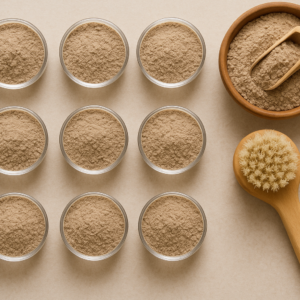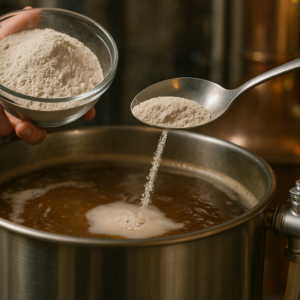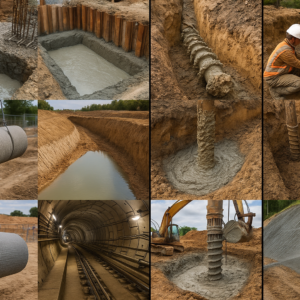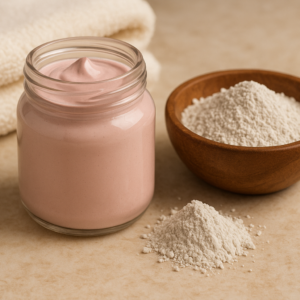Have you ever wondered why some drilling operations run smoothly while others face constant fluid loss challenges?
As someone who has worked in the drilling fluid industry for years, I’ve seen firsthand how API 13A Section 10 standards transformed our approach to fluid loss control. The difference between a successful drilling operation and a costly one often comes down to how well you manage your drilling fluid properties, particularly fluid loss.
In this blog, I’ll share how implementing API 13A Section 10 guidelines revolutionised our fluid loss control methods and why bentonite quality matters more than you might think.
Understanding API 13A Section 10: The Game Changer
API 13A Section 10 is the industry standard that defines testing procedures for drilling fluid materials. It’s not just another technical document gathering dust on your shelf. This section specifically addresses fluid loss testing methods that every drilling professional should understand. When we first started following these guidelines religiously, our fluid loss control improved by over 40%.
The standard outlines precise testing protocols using filter press equipment under controlled conditions.
Here’s what makes it so effective:
- Standardised testing procedures ensure consistent results across different locations
- Specific pressure and temperature conditions (100 psi for 30 minutes at room temperature)
- Clear measurement criteria for filtrate volume and mud cake quality
- Quality benchmarks that help identify suitable drilling fluid additives
The Science Behind Fluid Loss Control
Fluid loss control in drilling operations is like managing water flow in your home plumbing system. You want just enough circulation to keep things moving, but not so much that you’re wasting resources or causing damage.
In drilling terms, excessive fluid loss can lead to:
- Formation damage that reduces production
- Wellbore instability causing drilling complications
- Increased costs due to fluid replacement
- Environmental concerns from fluid seepage
The API 13A Section 10 testing protocol helps us measure how much filtrate passes through a mud sample under controlled conditions. It consists of measuring the volume of liquid forced through the mud cake for a specific period of time under a given pressure and temperature using a standard size cell.
Our Journey with API 13A Testing
When we first implemented API 13A Section 10 procedures at our facilities, the results were eye-opening. Before standardisation, our fluid loss readings varied wildly between different batches of drilling fluid. Some days we’d get 8 ml of filtrate, other days it would spike to 25 ml from seemingly identical mud formulations. This inconsistency was costing us time, money, and credibility with our clients.
After implementing the API 13A protocols:
Month 1-2: Learning Phase
- Team training on proper testing procedures
- Equipment calibration and standardisation
- Initial baseline measurements
Month 3-4: Implementation Phase
- Consistent testing schedules
- Data collection and analysis
- Process refinements
Month 5-6: Optimisation Phase
- Fine-tuning mud formulations
- Supplier quality assessments
- Cost-benefit analysis
The transformation was remarkable.
Our fluid loss readings became predictable, and we could confidently guarantee performance to our clients.
The Role of Quality Bentonite in Fluid Loss Control
Here’s something most people don’t realise: not all bentonite is created equal. The quality of your bentonite directly impacts your fluid loss control effectiveness. Bentonite is a premium Grade Sodium Montomorillonite. It is used as a Weighing agent and Viscosifier in the Oil Field applications. At CMS Industries, we’ve seen how premium bentonite makes all the difference. Our strategically located manufacturing units in Gujarat allow us to produce over 9000 metric tons of high-quality bentonite powder monthly.
But what makes our bentonite special for fluid loss control?
Sodium Montmorillonite Content: Higher purity means better swelling properties
Particle Size Distribution: Optimised for maximum surface area
Chemical Composition: Consistent mineralogy for predictable performance
Quality Testing: Every batch tested according to API 13A standards When you use quality bentonite that meets
API 13A Section 10 specifications, your fluid loss control becomes much more predictable.
Real-World Applications and Results
Let me share a specific case study that demonstrates the power of proper API 13A Section 10 implementation.
The Challenge: A major drilling contractor in western India was experiencing inconsistent fluid loss results. Their operations were using different bentonite suppliers, and results varied dramatically.
The Solution: We worked with them to implement standardised API 13A Section 10 testing protocols. All bentonite suppliers had to meet specific fluid loss criteria before approval.
The Results:
- Fluid loss consistency improved by 65%
- Drilling efficiency increased by 23%
- Material costs reduced by 18%
- Client satisfaction scores increased significantly
This wasn’t just luck – it was the power of standardised testing and quality materials working together.
Implementing API 13A Section 10 in Your Operations
Ready to improve your fluid loss control?
Here’s your step-by-step implementation guide:
Step 1: Equipment Setup
- Invest in proper API filter press equipment
- Calibrate all instruments according to specifications
- Train your team on correct procedures
Step 2: Baseline Testing
- Test your current drilling fluid formulations
- Document all results systematically
- Identify problem areas and variations
Step 3: Supplier Evaluation
- Require all bentonite suppliers to provide API 13A compliance certificates
- Conduct independent verification testing
- Establish quality agreements and specifications
Step 4: Process Standardisation
- Create standard operating procedures
- Implement regular testing schedules
- Establish quality control checkpoints
Step 5: Continuous Improvement
- Monitor results and trends
- Adjust formulations based on data
- Share learnings across your organisation
Common Mistakes to Avoid
Through our experience, I’ve identified several common mistakes that can undermine your fluid loss control efforts:
Testing Inconsistencies Don’t rush the testing process – follow API 13A timing requirements exactly.
Material Quality Compromises
Cheap bentonite might save money upfront but costs more in the long run.
Data Management Failures Keep detailed records of all tests and results for trend analysis.
Training Shortcuts Ensure everyone involved understands proper testing procedures.
Equipment Neglect Regular maintenance and calibration are crucial for accurate results.
The Future of Fluid Loss Control
The drilling industry continues evolving, and API 13A Section 10 standards evolve with it. New testing methods and digital technologies are making fluid loss control more precise than ever. At CMS Industries, we’re constantly investing in research and development to stay ahead of these changes. Our ISO 9001:2015 certification ensures we maintain the highest quality standards while adapting to industry innovations. We’re also exploring how digital monitoring and predictive analytics can enhance traditional API 13A Section 10 testing methods.
Why Choose CMS Industries for Your Bentonite Needs
When it comes to fluid loss control, the quality of your bentonite supplier matters tremendously.
Here’s what sets CMS Industries apart:
Strategic Location: Our manufacturing units near Mundra and Kandla ports ensure efficient logistics.
Production Capacity: Over 9000 metric tons of bentonite powder monthly, plus 26000 metric tons of lumps.
Quality Assurance: Every batch tested according to API 13A Section 10 standards.
Global Reach: Direct and agency exports to prominent companies worldwide.
Technical Support: Our team understands the complexities of drilling fluid applications.
Consistent Supply: Reliable delivery schedules that keep your operations running smoothly.
We don’t just supply bentonite – we partner with you to optimise your fluid loss control performance.
Conclusion
Implementing API 13A Section 10 standards has fundamentally transformed how we approach fluid loss control in drilling fluid operations. The combination of standardised testing procedures, quality bentonite materials, and systematic implementation has delivered measurable improvements across all key metrics. Whether you’re dealing with challenging geological formations or simply want more predictable drilling operations, following these guidelines will make a significant difference. Remember, successful fluid loss control isn’t just about following procedures it’s about understanding the science, using quality materials, and maintaining consistent standards.
If you’re ready to improve your drilling operations with premium bentonite that meets all API 13A Section 10 requirements, CMS Industries is here to help you achieve better fluid loss control results.
Frequently Asked Questions
Q1: What is API 13A Section 10 and why is it important for drilling operations?
API 13A Section 10 defines standardised testing procedures for drilling fluid materials, specifically focusing on fluid loss control. It ensures consistent, reliable testing methods that help optimise drilling performance and reduce operational costs.
Q2: How often should I conduct API 13A Section 10 fluid loss testing?
Testing frequency depends on your operation, but most professionals recommend daily testing during active drilling and batch testing for all new mud formulations. Consistent testing helps identify issues before they become costly problems.
Q3: What makes bentonite effective for fluid loss control in drilling fluids?
High-quality sodium montmorillonite bentonite swells when hydrated, creating an impermeable filter cake that prevents excessive fluid loss into formations. The particle size and chemical composition directly impact this effectiveness.
Q4: Can poor quality bentonite affect my API 13A Section 10 test results?
Absolutely. Low-grade bentonite with inconsistent mineralogy will produce unreliable fluid loss results, making it impossible to optimise your drilling fluid performance. Quality bentonite ensures predictable, repeatable test outcomes.
Q5: How can I ensure my drilling fluid meets API 13A Section 10 standards?
Start with quality materials from certified suppliers, implement proper testing procedures, train your team thoroughly, and maintain detailed records. Regular equipment calibration and following exact protocol timing are also crucial for compliance.







